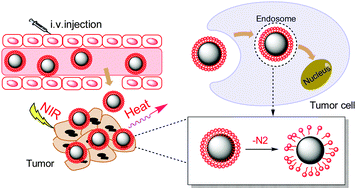Azo-functionalized Fe3O4 nanoparticles: a near-infrared light triggered drug delivery system for combined therapy of cancer with low toxicity
Abstract
To improve the therapeutic effect and decrease the toxicity in normal tissues, stimuli-responsive drug delivery systems have attracted extensive attention in tumor therapy. In this work, we present a smart drug delivery system based on the stimulated decomposition of a thermo-sensitive molecule, azobis[N-(2-carboxyethyl)-2-methylpropionamidine] (Azo), for the combined photothermal therapy and chemotherapy. Doxorubicin (DOX) was attached to the surface of magnetic nanoparticles (NPs) via the Azo linker. Upon irradiation with near infrared (NIR) light, local heating is generated by iron oxide nanoparticles (IONPs), which triggers the decomposition of the Azo molecule and the release of DOX. Compared with Fe3O4–DOX NPs, Fe3O4–Azo–DOX NPs demonstrate dominant advantages of stability, which results in the low toxicity of Fe3O4–Azo–DOX NPs in cardiac tissues. Fe3O4–Azo NPs display excellent photothermal effects under NIR laser irradiation and extremely low cytotoxicity towards MCF-7 cells. Furthermore, the Fe3O4–Azo–DOX NP system exhibits significantly enhanced cell killing effects upon irradiation with NIR, attributed to the synergistic therapeutic efficacy of photothermal chemotherapy.


 Please wait while we load your content...
Please wait while we load your content...